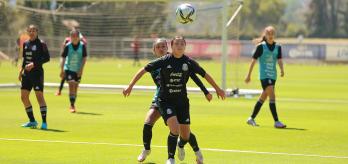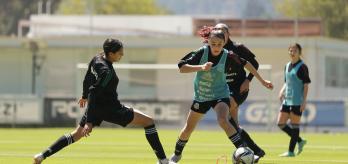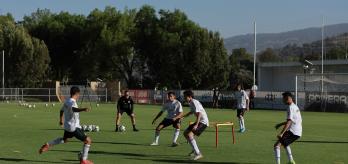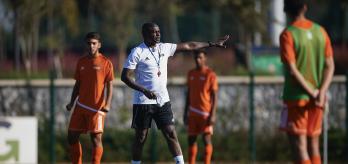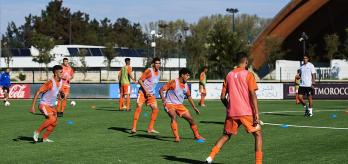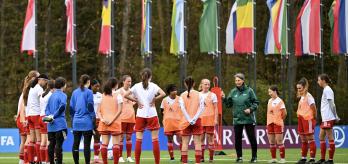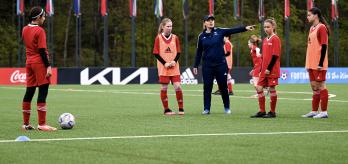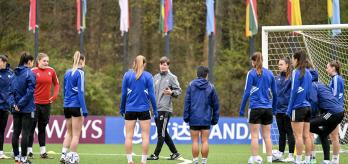In the modern game, defenders cannot afford to wait for opposition attackers to make the first move. Instead, defensive players need to be proactive and step up to win the ball or apply immediate pressure on the opposition. By focusing on sprint readiness, reaction speed and coordination in relation to their team-mates and the opposition, defenders can improve their chances of stopping a dangerous attack before it gets started.
In this session, FIFA Technical Expert Anouschka Bernhard delivers a series of exercises that focus on the key principles of forward defending. The session, which involves a group of young girls, starts with a coordination exercise that helps to prepare the players to move quickly towards a certain point. This initial exercise is followed by two passing drills that give the players the chance to work on quick movements and decision-making during a transition. The players then work in a larger playing area, in which they are asked to adopt a similarly aggressive approach to defending. The session is rounded off with a small-sided 6v3 that transitions into a 9v9 on a bigger pitch.
Session overview
Key coaching points
-
In order to successfully defend on the front foot, players must adopt an aggressive approach and display quick reaction times.
-
Being ready to sprint at all times will enhance the defenders’ chances of stepping out to win the ball and preventing an attack.
-
When a defender steps out of the defensive line, the other members of the defensive unit must focus on their positioning and the opposition’s movement.
-
Purposeful pressing can be key to preventing an in-possession player from progressing. If the press lacks intensity or purpose, it can easily be overcome.
Part 1: coloured cone game
This first exercise is designed to improve the players’ reaction times and their ability to perform quick directional changes. Players must quickly identify their target and move towards it in coordination with their team-mates, just as they would if they were hunting down the ball.
-
Mark out a 20x25m playing area using different coloured cones.
-
Ensure that a cone of each colour is placed on all four sides of the playing area.
-
Place a different coloured cone in each of the four corners.
-
Divide the group into four teams of 5 and give each team a different coloured bib.
-
Distribute the coloured cones evenly amongst all of the players.
-
Place eight to ten balls in the playing area.
-
Players dribble freely within the playing area while carrying a cone in their hand.
-
The out-of-possession players look to receive a pass from an in-possession player.
-
The coach gives the players various tasks to perform, both with and without the ball, and they swap cones as they pass one another.
-
On the coach’s command, either based on the colour of their bib or the cone that they are holding, the players either dribble or run around a cone or to a corner of the playing area.
-
If the coach shouts “corner”, all of the players have to go to the corner cone that is the same colour as the cone that they are holding.
-
If the coach shouts “colour”, the players have to dribble around a cone that is the same colour as the bib that they are wearing.
-
This exercise allows the players to work on the fundamentals of forward defending, such as reaction times and sprint readiness.
-
Ask the players to perform the tasks at very high intensity.
Part 2: ball hunting- throw ins
In this drill, the players are required to react quickly to a neutral player’s command and sprint to hunt down the ball. The first part of the exercise involves the players throwing the ball to each other, which allows them to familiarise themselves with the ball before having to quickly transition into a press.
-
Mark out a 24x18m playing area.
-
Place a dummy 5m outside of the playing area (on all four sides).
-
Divide the group into two teams of 4, plus 2 neutral players.
-
Give each team a ball.
-
The players on each team throw the ball to each other.
-
The throwing sequences must also involve the neutral players.
-
One of the neutral players calls out a colour to initiate the action.
-
The players belonging to the team that is called out try to retain possession of the ball, while the other team leave their ball and become the hunting team.
-
If the in-possession team (including the neutral players) complete five passes and then hit a dummy with a throw-in, they are awarded one point.
-
If the hunting team block or intercept a pass, they are awarded one point.
-
This exercise allows the players to work on the fundamentals of forward defending, such as reaction times, sprint readiness and aggressive pressing.
-
Emphasise the importance that the hunting team perform the exercise at high intensity.
-
Ask the players on the hunting team to run purposefully towards the in-possession player.
Part 3: Keep possession
As a progression of the initial part of the exercise, the players now pass the ball along the ground using their feet. The out-of-possession team have a numerical disadvantage, which forces them to react quickly in the press and be on the front foot.
-
Arrange the players into two teams: 6 attackers v. 3 defenders.
-
Place the 3 defenders outside the playing area.
-
Position the 6 attackers inside the playing area and give them a ball.
-
The attacking players begin the exercise by passing the ball to each other in an unopposed situation.
-
On the coach’s command, the first blue defender enters the playing area and tries to win the ball.
-
After seven seconds, the next blue defender joins their team-mate in the playing area to try and win the ball, and seven seconds later, a third blue defender enters the playing area.
-
If the defending team recover possession with 1 defender in the playing area, they earn three points.
-
If the defending team recover possession with 2 defenders in the playing area, they earn two points.
-
If the defending team recover possession with 3 defenders in the playing area, they earn one point.
-
If the attacking team complete five passes, they earn three points (even in the 6v3 scenario).
-
Ask the teams to swap roles after a certain period of time.
-
Reduce or extend the period between which each blue defender enters the playing area.
-
Allow each of the defenders to enter the playing area from different sides.
-
Given the high intensity at which the exercise should be performed, ensure that an adequate number of breaks are planned.
-
Encourage the defenders to use their defensive shadows effectively to cut off the attacking players’ passing options.
Part 4: 6v4 into a 6v5
The third part of the session involves a small-sided game in which the defensive team are asked to attack aggressively and take advantage of the opposition’s vulnerability immediately after an attack has finished.
-
Set up a 30x20m playing area.
-
Place three mini-goals an equal distance apart along one of long sides of the playing area.
-
Divide the group into two teams of 6.
-
Set up a game scenario with 6 attackers v. 4 defenders inside the playing area.
-
Place the 2 spare blue players each side of the central mini-goal and give them a ball each.
-
The orange team progress play by passing the ball between themselves and aim to pass it into one of the three mini-goals.
-
The blue team try to win the ball back and prevent the orange team from passing the ball into one of the mini-goals.
-
Immediately after the oranges play a pass into a mini-goal (or attempt to do so), one of the 2 blue players positioned either side of the central mini-goal enters the playing area with a ball to help their team progress play to the opposite end of the playing area in a 5v6 scenario.
-
Both spare blue players can enter the playing area.
-
Immediately after an attempt – whether successful or otherwise – to pass the ball into one of the mini-goals, all of the orange-team players transition into defence, pressing the in-possession player and closing off passing lanes.
-
Ask the defenders to position themselves close to each other.
Part 5: counter-attacking in a 9v9
The final exercise gives defenders the opportunity to step out of the defensive line and close down attackers when the opposition transition into attack. The defenders are asked to focus on timing of movement and adopting an aggression approach when stepping out, whilst the other members of the defensive unit should focus on their positioning and shape.
-
Mark out a 60x40m playing area.
-
Set up two full-size goals and place a goalkeeper in each goal.
-
Use cones to mark out a defensive line across the width of the playing area, 20m from one of the goals.
-
Mark out a 20x20m playing area directly in front of the other goal.
-
Place a cone at the midpoint of each of the shorter sides of the small playing area.
-
Place a cone on each touchline of the larger playing area and parallel to the cones that mark the end of the small playing area.
-
Use cones to create a line between the cones positioned on the touchlines and the cones that mark the midpoint of the shorter sides of the small playing area.
-
Arrange a four-player defensive unit behind the defensive line and position 3 orange forwards in this zone.
-
Place a blue counter-attacking forward on each side of the small playing area.
-
Position 6 orange players and 3 blue players inside the small playing area.
-
The orange team try to exploit their numerical advantage in the small playing area to play the ball into one of the 3 orange forwards.
-
Once this pass has been played, a player from each team is allowed to leave the small playing area and participate in the move.
-
If the blue team win the ball, they counter-attack towards the opposite goal with the help of the 2 wide forwards.
-
The other orange defenders may only leave the small playing area once the ball has crossed the defensive line.
-
When the ball goes out of play or if a goal is scored, restart the sequence with the 6v3 scenario in the small playing area.
-
The offside rule does apply.
-
The attackers must take an attempt on goal within ten seconds of the ball entering the attacking zone.
-
All players can move freely between the zones.
-
The players positioned on the edge of the penalty area should only move towards goal or leave the area after receiving a pass.
-
Given the numerical advantage in favour of the defending team within the zone marked by the defensive line, one of the defenders can step out without exposing their team-mates.
-
When passes are played into centrals areas, the central defender nearest the ball should step out, while the rest of the defenders offer defensive cover by forming a defensive triangle.
-
When passes are played into wide areas, the full-back nearest the ball should step out, while the rest of the defenders provide defensive cover by forming a defensive arc.
-
Ensure that the in-possession team communicate well and display good coordination at all times.








